To tailor a vintage peacoat, start by checking its fit since these often run smaller than modern styles. You might need to size up one or two sizes for comfort. Focus on taking in the sides and back to eliminate excess fabric while keeping the coat's original silhouette. Adjust sleeve lengths if there's enough seam allowance, and verify shoulders align with your natural lines. Communicate clearly with your tailor about your preferences, and maintain the peacoat's classic design. With a little care and attention, you can keep your peacoat looking sharp and ready for any occasion. There's more to explore on achieving the perfect fit!
Understanding the Vintage Peacoat Fit
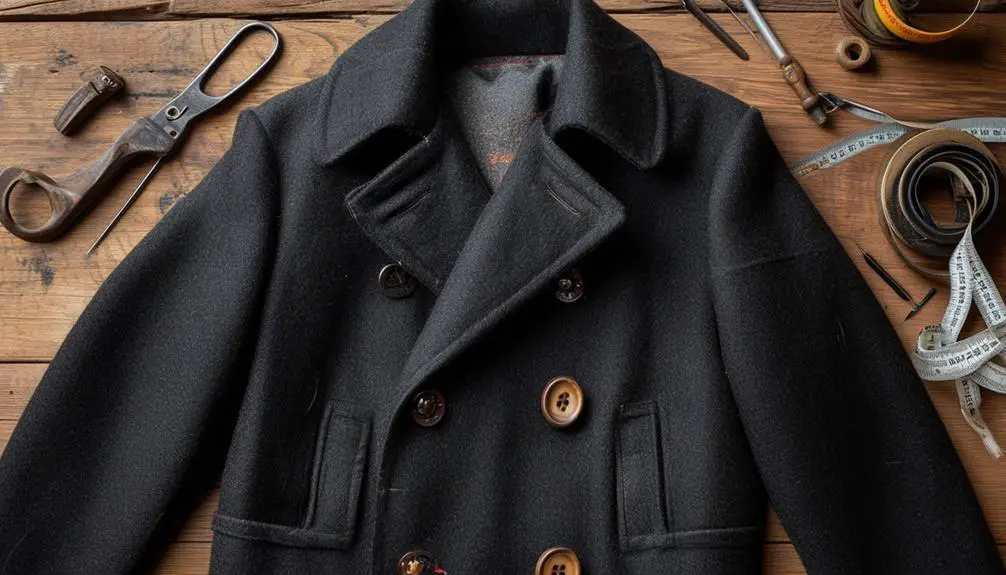
When it comes to vintage peacoats, understanding the fit is vital for achieving a polished look. These classic garments often fit smaller than their modern counterparts, so you might need to size up, especially if you plan to layer underneath. For instance, if you have a 40-inch chest, a vintage pea coat in size 40 or 42 will likely provide the best comfort.
Vintage clothing often reflects unique designs and craftsmanship from specific eras, which can enhance your style vintage clothing characteristics.
Don't forget to check the sleeve lengths, as they can be shorter than today's styles. Measuring your arm length before making a purchase is important to avoid an awkward fit.
The square-cut design typical of vintage peacoats can appear boxy, so consider how it complements your body type. Tailoring can help create a more flattering silhouette if necessary.
Lastly, sizing tags can be misleading. Always verify the actual measurements by checking the pit-to-pit and shoulder width. This attention to detail guarantees you'll find the perfect vintage pea coat that not only fits well but also enhances your style.
Essential Tailoring Techniques
To achieve the perfect fit for your vintage peacoat, mastering a few essential tailoring techniques is key. Preserving the coat's original square-cut silhouette is vital, as any drastic alterations can compromise its authenticity.
Vintage clothing often features unique design elements and craftsmanship, making attention to detail even more important. Here's a breakdown of techniques to guarantee your peacoat looks sharp and tailored:
- Take in the Sides and Back: Reduce excess fabric while maintaining the classic fit.
- Align the Shoulders: Confirm they match your natural shoulder lines for a clean and tailored appearance.
- Check the Sleeve Length: With sufficient seam allowance, a skilled tailor can often lengthen sleeves by over an inch.
- Steam Pressing: Use steam to shape the fabric and eliminate creases from old hems, promoting a polished finish.
During the fitting process, consider using basting stitches. They allow for easy adjustments and guarantee your peacoat retains a consistent look inside and out.
Key Alterations for Peacoats
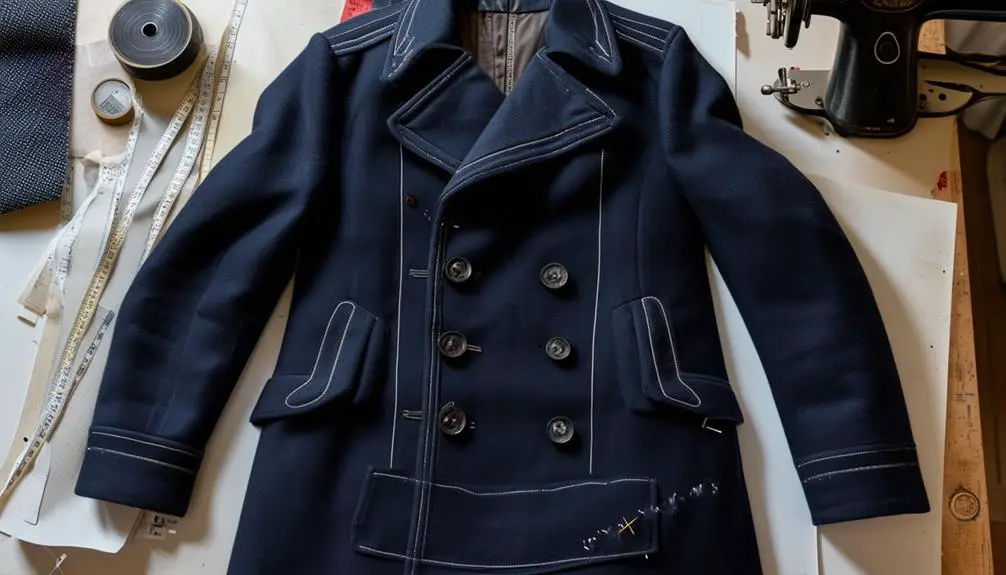
Transforming a vintage peacoat into a perfectly fitted garment often hinges on a few key alterations. One of the most common adjustments is taking in the sides and back. This helps reduce excess fabric, creating a tailored silhouette while preserving the coat's traditional structure.
You'll likely want to address the sleeve length as well. A good tailor can lengthen the sleeves if there's enough seam allowance—typically around one inch—ensuring your arms look and feel right.
Another significant alteration involves refining the shoulder seams for an improved fit. However, be aware that this adjustment can be complex and may increase your alteration costs.
Throughout the process, it's essential to maintain the original square-cut design of your peacoat. The goal is to enhance its appearance without compromising its authentic style.
Don't forget that communication is key. Clearly express your desired fit and style to your tailor, as this will facilitate more successful alterations.
Choosing the Right Tailor
Finding the right tailor for your vintage peacoat is vital to achieving the perfect fit and preserving its classic charm.
You want someone who understands the nuances of heavy fabrics, especially wool, so your peacoat remains as timeless as ever.
Here are four key points to take into account when choosing a tailor:
- Specialization: Look for local tailors who specialize in outerwear alterations. Their expertise will make a difference in the quality of adjustments.
- Reputation: Ask for examples of previous work or read reviews. A tailor's reputation can be a strong indicator of their ability to maintain your peacoat's original design.
- Convenience: Reflect on the tailor's location and availability. Multiple fittings may be necessary, so it's best if they're nearby.
- Communication: Clearly express your tailoring needs, emphasizing the importance of the traditional square-cut silhouette while allowing for comfort.
Inquire about their experience with vintage garments, as specific techniques may be required to protect your coat's structure.
With the right tailor, you'll guarantee your vintage peacoat continues to be a stylish staple in your wardrobe.
Maintaining Authenticity in Tailoring
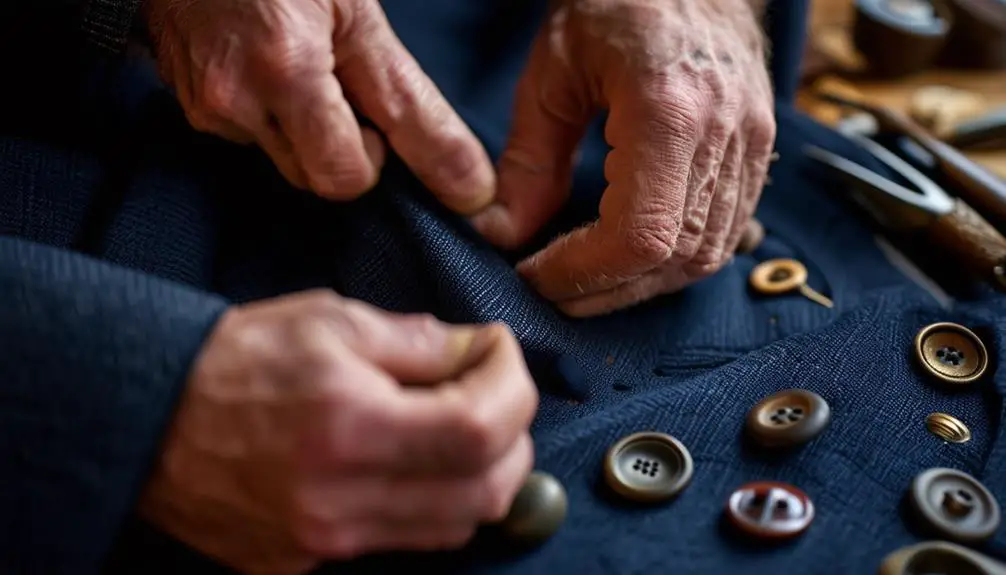
Maintaining the authenticity of your vintage peacoat during tailoring is essential for preserving its timeless appeal. Start by keeping the traditional square-cut silhouette intact, as this design element is critical to the overall authenticity of pea coats.
Avoid excessive alterations that could change the coat's original structure; remember, vintage peacoats are meant to fit loosely to allow for layering.
When you consult with a tailor, choose one experienced in heavy wool and structured garments. They'll understand the unique properties of the fabric and the original construction techniques used in vintage pea coats. This expertise will help guarantee any adjustments enhance, rather than compromise, the coat's integrity.
As you consider alterations, like taking in the waist or adjusting sleeve length, make certain they don't affect the coat's warmth and protective qualities—especially in colder weather.
Retaining the original button configuration and placement, typically 8×4, is also essential to upholding the classic naval-inspired aesthetic.
Common Sizing Challenges
Maneuvering the sizing of vintage peacoats can be a bit tricky, especially since they often adhere to different standards than what you're used to in modern styles.
You might find yourself facing several common sizing challenges that require your attention. To help you navigate this, make sure to keep in mind the following:
- Misleading Size Tags: Vintage peacoats often have tags that don't reflect real measurements. Always measure before buying.
- Tighter Fits: Expect a snugger fit in the chest and shoulders. Vintage cuts typically lack the extra room that modern styles provide.
- Size Up: Many users recommend purchasing one or two sizes larger for that comfortable fit you crave.
- Variability in Styles: Different vintage styles can have inconsistent arm lengths and shoulder widths, so trying on multiple sizes is essential.
Tips for Successful Alterations
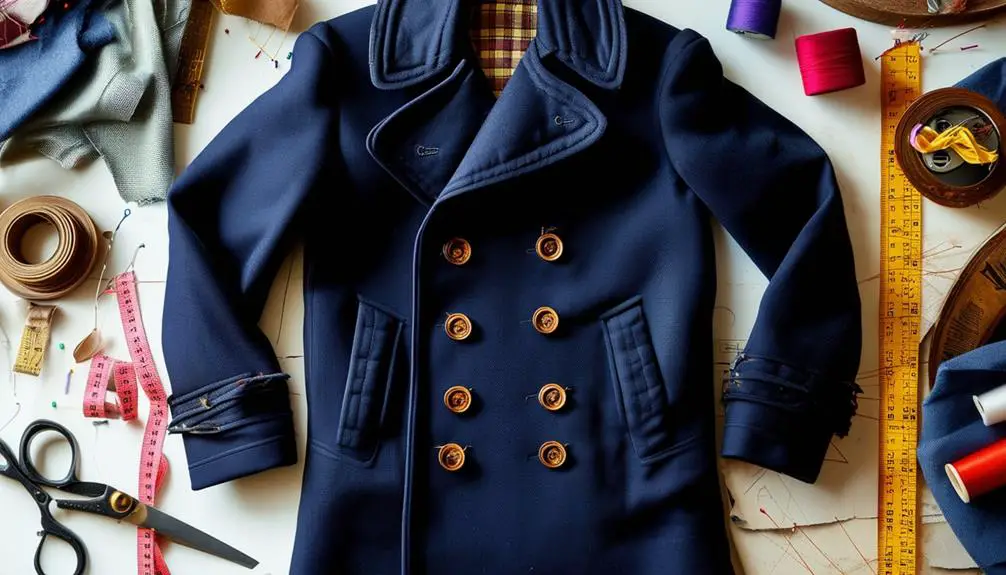
Maneuvering the sizing challenges of vintage peacoats is only the first step; successful alterations can truly bring your unique find to life. To achieve the perfect fit, communicate clearly with your tailor about your desired outcomes. Focus on specific adjustments, like taking in the sides or lengthening sleeves, while ensuring the traditional square-cut silhouette remains intact. This will help preserve the coat's authentic style.
Before diving into alterations, inspect the fabric for wear and potential damage. Vintage materials might require special handling to avoid visible differences post-tailoring. Remember that vintage peacoats often have limited seam allowances, so consult with your tailor about how much can be altered without compromising the coat's structure and appearance.
During the fitting process, consider having the coat pinned. This allows you to visually assess how the alterations will affect the fit and style, ensuring you're satisfied with the results.
Pay particular attention to the placement of the top buttons; they should sit comfortably and align with your body's natural shape. With careful planning and execution, your vintage peacoat won't only fit like a glove but also celebrate its timeless charm.
Post-Tailoring Care and Maintenance
Your newly tailored vintage peacoat deserves the best care to affirm it remains a cherished part of your wardrobe for years to come. With a few simple maintenance steps, you can keep it looking sharp and feeling great.
- Brush Regularly: Use a soft clothes brush to remove dirt and lint, maintaining its appearance and fabric integrity.
- Proper Storage: Hang your peacoat on a sturdy wooden hanger, affirming it has extra room in your closet to avoid crushing and preserve its shape.
- Follow Cleaning Instructions: Stick to the manufacturer's recommendations, usually opting for dry cleaning to maintain the quality of the wool without risking shrinkage.
- Rotate Your Outerwear: Give your peacoat a break by alternating it with other coats, allowing the fabric to rest and regain its natural shape.
Additionally, inspect seams and buttons frequently for any signs of wear.
Address minor repairs promptly to extend your peacoat's life.
With these care tips, you'll affirm your tailored treasure remains a timeless staple in your wardrobe, ready for many seasons to come.
Frequently Asked Questions
Can a Peacoat Be Tailored?
Yes, you can tailor a peacoat, but be cautious. Preserving its classic silhouette is key. A skilled tailor can adjust sides and sleeves while ensuring the coat retains its original charm and functionality for layering.
Can a Tailor Adjust a Wool Coat?
Yes, a tailor can adjust a wool coat to enhance its fit. They can take in sides, shorten sleeves, or taper the waist, ensuring the coat flatters your unique body shape while maintaining its structure.
How Do You Restore a Pea Coat?
To restore your peacoat, start by cleaning it thoroughly, inspecting for damage, and making necessary repairs. Consider dyeing it if faded, replacing buttons for authenticity, and regularly brushing and storing it properly to maintain its shape.
Are Peacoats Supposed to Be Tight?
Peacoats aren't meant to be tight; they're designed for comfort and movement. Embrace their classic, relaxed fit, which allows for easy layering and retains the coat's traditional charm, ensuring you stay warm and stylish.
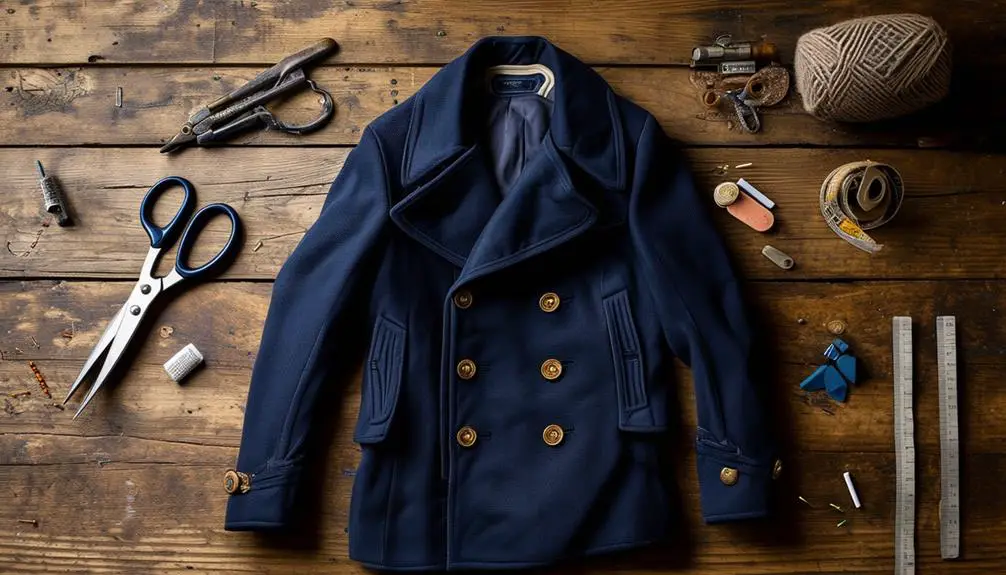



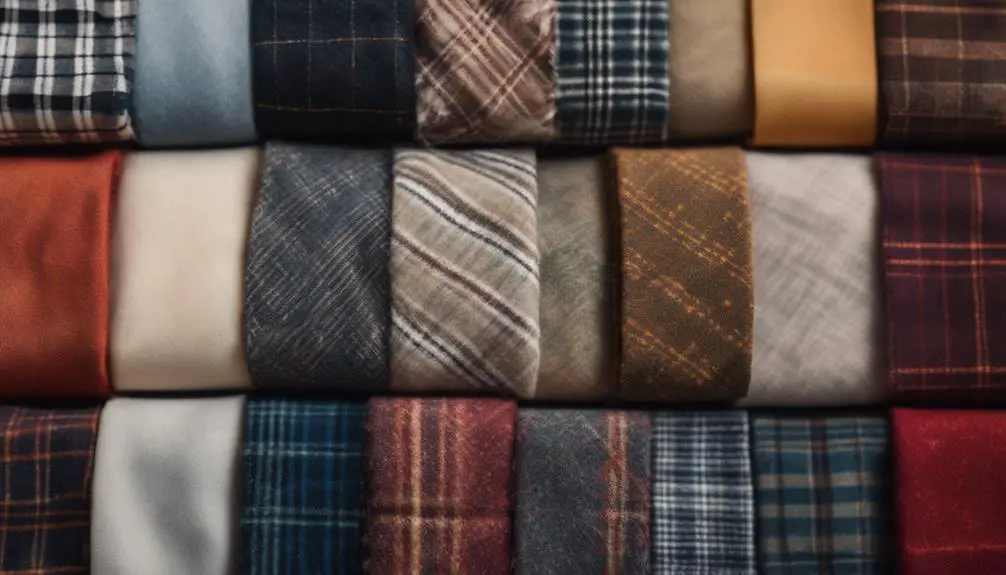
Please provide me with more details on the topic http://www.ifashionstyles.com
Your articles are very helpful to me. May I request more information? http://www.kayswell.com
Thank you for your post. I really enjoyed reading it, especially because it addressed my issue. http://www.kayswell.com It helped me a lot and I hope it will also help others.
Thanks for posting. I really enjoyed reading it, especially because it addressed my problem. http://www.kayswell.com It helped me a lot and I hope it will help others too.
Thanks for another informative web site. Where else may just I get that kind of information written in such an ideal approach? I have a challenge that I am simply now operating on, and I’ve been at the look out for such info.